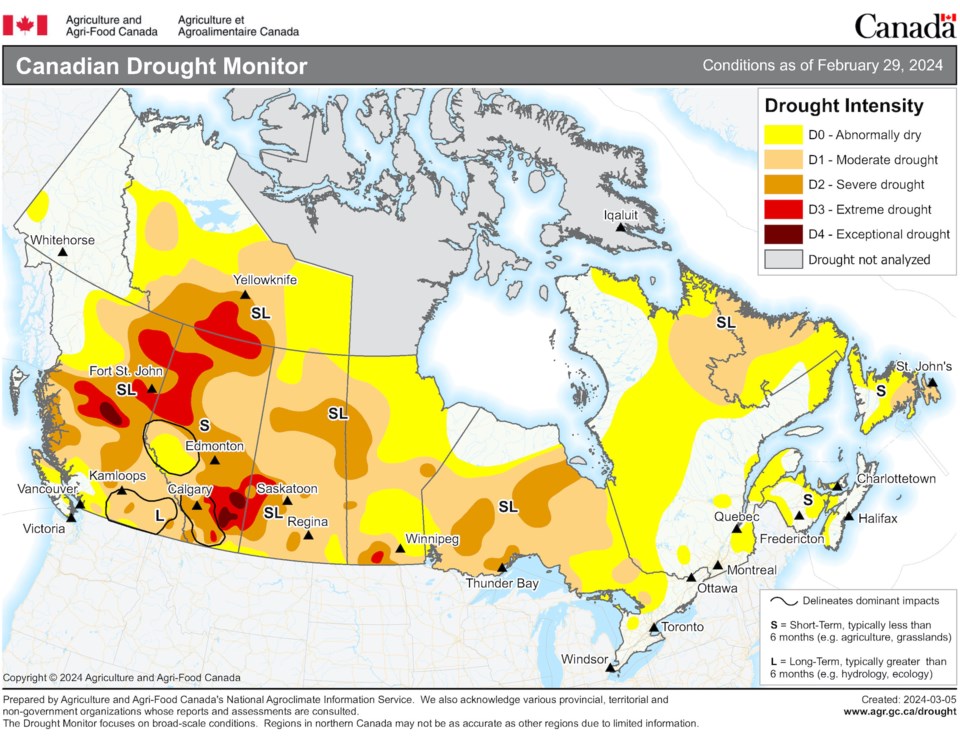ATHABASCA — In Athabasca, spring has almost sprung — ice-packed roads have melted, snow-covered lawns are returning to various shades of brown, and questions of drought still are on the minds of many leaders across the province.
Minister of Environment and Protected Areas Rebecca Schulz made an announcement March 13 about the province’s response to looming threats of drought across Alberta, highlighting a $35 million dollar investment in drought resistance contained in the 2024 proposed budget.
“We’re doing advanced modelling and working with industry, municipalities, Indigenous groups, and many others to make every drop this year count,” said Schulz.
Some $23 million over the next three years will be delegated to water storage projects and upgrades, and improvements and updates to the water management system if the 2024 budget is passed.
The funds would also go towards improving conservation efficiency and modernizing the water management information system to provide up-to-date information to Albertans.
Along with the financial commitments made in the budget, she also highlighted the importance of being prepared for less-than-ideal weather and climate patterns.
“We’re far from finished,” said Schulz. “We also need to think about resiliency and long-term plans for multi-year drought and flood conditions.”
Schulz comments on strategic preparation come less than a week after two northern Albertan watershed councils hosted a day-long session in Athabasca aimed at municipal preparedness ahead of long-lasting drought conditions. The session was attended by more than 50 representatives from six northerly regions and a number of water advocacy groups.
“It was great to see, we had representatives from the M.D. of Lesser Slave River, the County of Barrhead, the County of Athabasca, the Town of Athabasca, and Lac La Biche County, so it was great to pull from that whole area,” said Petra Rowell, executive director of the Athabasca Watershed Council (AWC) in a March 15 interview.
The AWC hosted the event along with the Lesser Slave Watershed Council (LSWC) at the Athabasca and District Seniors Centre. The all-day seminar consisted of presentations from AWC and LSWC staff on the history of drought in Alberta, the status of the Athabasca watershed, and the roles and responsibilities of municipalities in addressing and preparing for dry conditions.
According to data from Alberta River Basins and the Alberta government updated March 10, some 51 water shortage advisories are active across the province. Three of those advisories, for Clearwater River, the Ells and Steepbank Rivers, and the Firebag River, fall within the Athabasca River Basin.
The Hay River Basin currently has two active advisories, and the Peace River Basin has seven active advisories. The remaining 39 advisories pertain to basins in the south of the province, mainly in the Bow River, South Saskatchewan, and Oldman River basins.
Heavier than normal precipitation — ranging from 100 millimetres up to 170 millimetres — in February did have an impact on parts of the province. According to agricultural moisture data published Feb. 28 by the province, “the moisture gap does appear to be narrowing in some areas, and hopefully this trend continues well into the spring and summer.”
However, northern Alberta saw much lower levels of precipitation, ranging from one to 10 millimetres in February. “Snow packs are still critically low here, which is a serious concern heading into the fire season,” reads the Feb. 28 ag moisture report.
Up to date information on flow levels and water advisories can be accessed at https://rivers.alberta.ca/Contents/WaterSupply/2024/2/.
Municipal responsibilities
“Water management in Alberta is complicated,” Rowell told attendees. “There’s no one agency responsible for all aspects of water management, including flood and drought, and that’s probably true of most jurisdictions because it is a complicated topic.”
AWC and LSWC are two of 11 Watershed Planning and Advisory Councils (WPACs) across the province. Designated by the provincial government to monitor and report on the watersheds in Alberta, Rowell said the real strengths of the WPACs lie in their ability to curate information and provide municipalities with answers.
“The thing that Watershed Councils are really good at is convening and collaborating,” she said. “If we have a question or something, we might not have the answers ourselves, but we’ve got a lot of contacts into different government agencies and we can try and help them find the information.”
The seminar pulled material from the Alberta Water Council’s updated guide, Building Resiliency to Multi-Year Drought in Alberta. In addition to lessons learned from the 2001 drought and the differences between drought types, the 136-page document lays out a detailed list of actors in Alberta’s water world, and the aspects of management under their jurisdiction.
While the province is responsible for operating infrastructure and implementing water-related legislation across Alberta, local municipalities play their own role in drought response and, equally as important, drought preparation.
Bylaws for drought-tolerant planting and landscaping, policies around water use and conservation during shortages, and emergency response plans, among other options, were listed as tools available to municipalities when planning for drought.
Athabasca County Reeve Brian Hall said the workshop and guide contained useful information for the upcoming season and further into the future.
“In our region it looks like it will be less of a problem certainly than in the south, but we’re not without some risks here also,” said Hall. He added the seminar highlighted the importance of proper planning, especially ahead of the upcoming fire season.
“That’s something that is obviously a much greater risk for our region and something that I know our administrative team is working on being well-prepared for,” said Hall.



